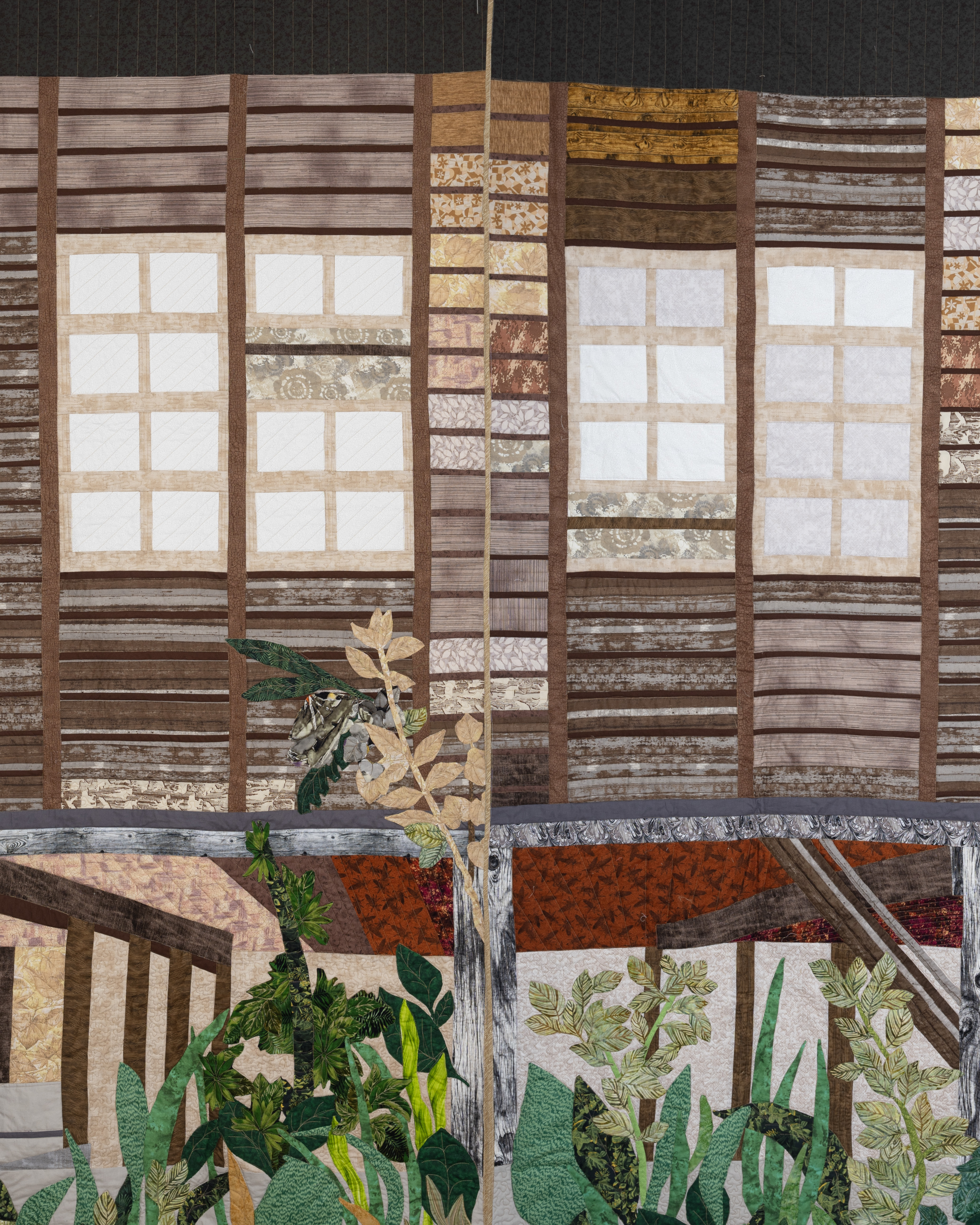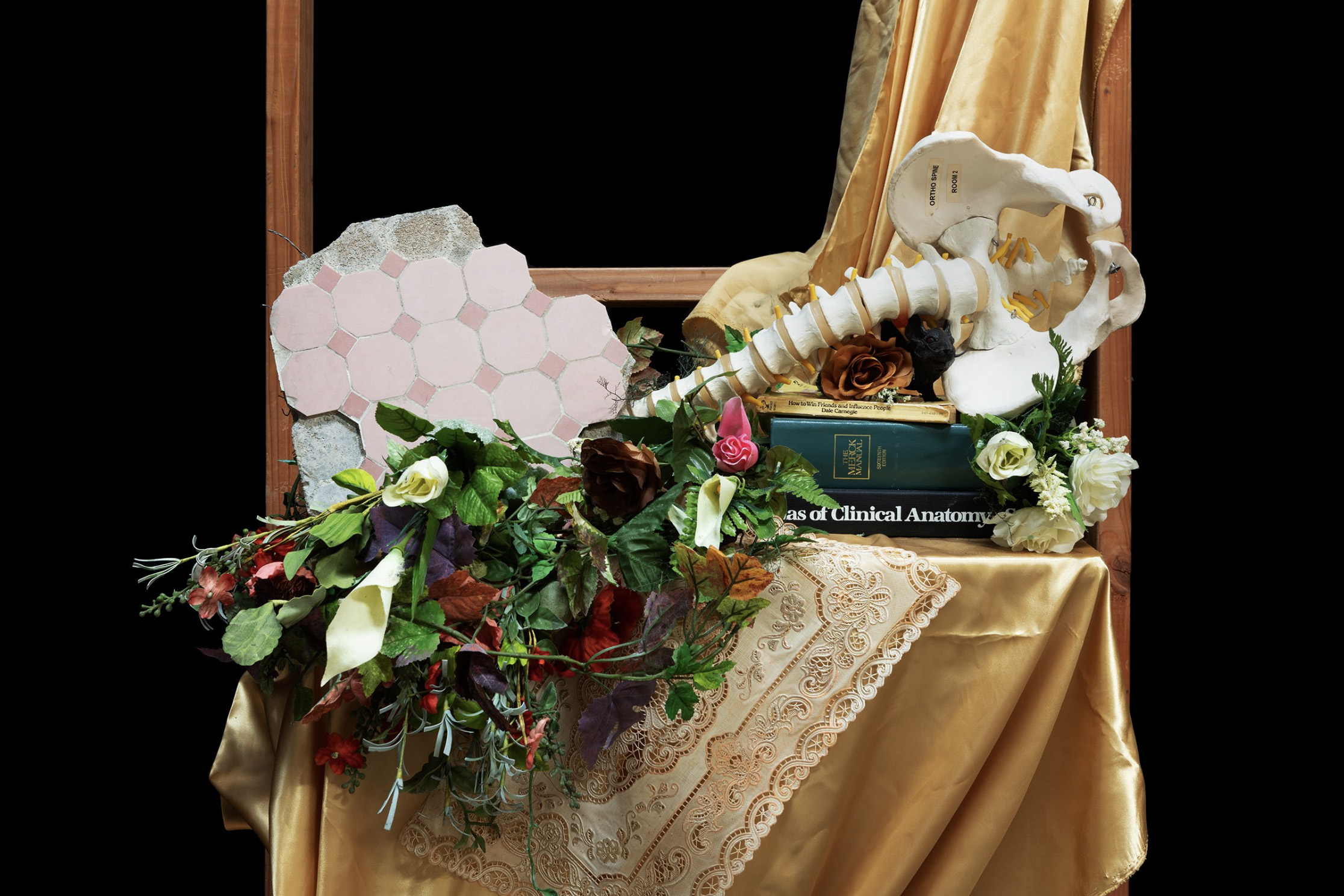
Images throughout courtesy of the artists and the author
Balikbayan
By Kija Lucas
“Balikbayan. Its literal translation is return (balk) home/country (bayan) it’s a term used to distinguish Filipinos who have lived/worked overseas and return home. Me and my mom are balikbayans and we look back at our old home and remember it through our quilted works.”
- Mik Gaspay
Depending on who is telling the story, the meaning of home can change. It might conjure the shape of a structure or the feeling of a warm hug. It might evoke the taste of a favorite meal or the smell of wet sidewalk. Some homes hold footsteps of our ancestors; the laughter of children might echo off the walls. Others hold hard things, things unspoken, bottled up, or sealed away. Most homes hold any and all of these things.
When a house no longer stands, or new residents have moved in, where do we hold all that was once found in that place? What do we pass on to future generations?
May and Mik Gaspay, are a mother and son who collaborate on quilted objects. Each of the artists approaches quilting from a very different perspective. Mik is an artist whose previous works in print and sculpture are more conceptually oriented. And May, who has in-depth experience with quilting, is more mathematical. Each had to learn the push and pull, not only of navigating family dynamics in collaboration, but also, of the just so geometric traditions of quilting and the wild possibilities of bucking those traditions to make three dimensional structures and organic botanical shapes that escape the two dimensional form. Without the back and forth of the collaboration, these works may become too geometric and mathematical or too organic and wild, “but,” as Mik Gaspay explains, “the strength of the foundation holds so that I can be messy without jeopardizing the whole piece.”
![]()
Their work together began by creating quilts of May’s grandfather’s home in the Philippines. This home, depicted in a large four panel quilt hanging away from the wall, housed generations of family members over time. By the time they began quilting, the jungle had long ago claimed the structure of the house, a loss at once beautiful and devastating. This home—where May grew up and several generations of their family had lived—was now gone.
While quilts are common domestic objects, Mik felt less of an attachment to the tradition, “it is not really part of my family history or tradition… it is more of a tradition that we are adopting.”
![]()
Pintuan, or The Door, is a quilt in two panels. One is at an angle to the wall, a front door made from fabric printed with the textures of wood in shades of brown and embroidered with names of the family members who lived in the home. The other quilt, parallel to the wall, depicts the jungle, with bright and deep green, brown, blue, fabric pieces sewn and quilted in the shape of botanicals. Pintuan makes space for us, the outside, to come inside.
Stepping between the open door and this threshold to spend time with the piece is an intimate gesture. There is only space for one person at a time to get close enough to see the work’s detail. The quilted botanicals layered atop one another break free from a traditional quilt. The edges are exposed, and sometimes fall away from the piece, adding movement and plantness. A monstera leaf, printed in fabric, is cut out and attached with applique. Other quilted plants are stuffed with batting and become three-dimensional. Colorful pieces of fabric are cut out and sewn together in the shape of leaves.
![]()
![]()
![]()
![]()
A quilt, functionally used to keep warm and generally at home, is often passed down and gifted between generations. The quilt becomes art within and depicting the home, a new way to hold stories, and memories. It is a mode to pass on home from generation to generation. Long after the natural world reclaimed the childhood house of May Gaspay, Ancestral Home, became a new place to hold the feeling of home.
When a house no longer stands, or new residents have moved in, where do we hold all that was once found in that place? What do we pass on to future generations?
May and Mik Gaspay, are a mother and son who collaborate on quilted objects. Each of the artists approaches quilting from a very different perspective. Mik is an artist whose previous works in print and sculpture are more conceptually oriented. And May, who has in-depth experience with quilting, is more mathematical. Each had to learn the push and pull, not only of navigating family dynamics in collaboration, but also, of the just so geometric traditions of quilting and the wild possibilities of bucking those traditions to make three dimensional structures and organic botanical shapes that escape the two dimensional form. Without the back and forth of the collaboration, these works may become too geometric and mathematical or too organic and wild, “but,” as Mik Gaspay explains, “the strength of the foundation holds so that I can be messy without jeopardizing the whole piece.”

Their work together began by creating quilts of May’s grandfather’s home in the Philippines. This home, depicted in a large four panel quilt hanging away from the wall, housed generations of family members over time. By the time they began quilting, the jungle had long ago claimed the structure of the house, a loss at once beautiful and devastating. This home—where May grew up and several generations of their family had lived—was now gone.
When the physical building does not exist we must find other ways to hold and pass on stories.
While quilts are common domestic objects, Mik felt less of an attachment to the tradition, “it is not really part of my family history or tradition… it is more of a tradition that we are adopting.”

Pintuan, or The Door, is a quilt in two panels. One is at an angle to the wall, a front door made from fabric printed with the textures of wood in shades of brown and embroidered with names of the family members who lived in the home. The other quilt, parallel to the wall, depicts the jungle, with bright and deep green, brown, blue, fabric pieces sewn and quilted in the shape of botanicals. Pintuan makes space for us, the outside, to come inside.
Stepping between the open door and this threshold to spend time with the piece is an intimate gesture. There is only space for one person at a time to get close enough to see the work’s detail. The quilted botanicals layered atop one another break free from a traditional quilt. The edges are exposed, and sometimes fall away from the piece, adding movement and plantness. A monstera leaf, printed in fabric, is cut out and attached with applique. Other quilted plants are stuffed with batting and become three-dimensional. Colorful pieces of fabric are cut out and sewn together in the shape of leaves.




A quilt, functionally used to keep warm and generally at home, is often passed down and gifted between generations. The quilt becomes art within and depicting the home, a new way to hold stories, and memories. It is a mode to pass on home from generation to generation. Long after the natural world reclaimed the childhood house of May Gaspay, Ancestral Home, became a new place to hold the feeling of home.

San Francisco Bay Area artist Kija Lucas uses photography to explore ideas of home, heritage, and inheritance. She is interested in how ideas are passed down and seemingly inconsequential moments create changes that last generations. Lucas has exhibited her work at The Guardhouse with For-Site, SF Camerawork, Oakland Museum of California, and the International Center for Photography. She has been an artist in residence at Montalvo Arts Center and Recology San Francisco. Lucas is currently the curator of the Arts at CIIS.
Shown above and below: work from Lucas’ series Still, Life

